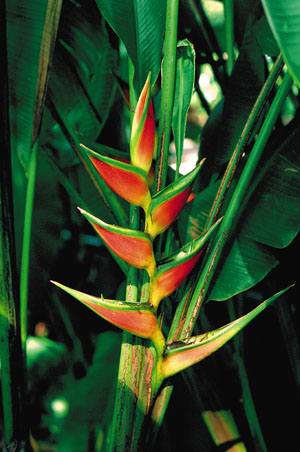August 2001
Did you know that
the name "heliconia" actually comes from
Greek mytholody after the great Mount Helicon?
Heliconia

Heliconia
|
Heliconias
(pronounced "hell-ee-cone-ee uh") are one of the main
families of tropical flowers in Central America. These durable exotic
flowers are known throughout the world for their beauty and rightly so.
If taken care of properly certain cut heliconia flowers can stay
beautiful and look fresh for up to a month! Originally the heliconia
family comes from the American Tropics. Over 89 species are recognized,
all of which are placed in the single family of Heliconia. There are
more than 350 varieties of heliconia all in all, of which about 98
percent are native to tropical America. Heliconia plant sizes vary
between 1 1/2-foot dwarfs to 30-foot tree-sized giants. Most
noticable are the flower's bright colors which come in a wide range of
hues and combinations from reds, oranges, and whites to greens,
yellows and pinks.
Helicona come in two main orientations, erect and
pendent. The differnece is easily seen by looking at the bracts, the
petal-like "spikes" on the side of the flowers, and which
way they are pointed. Erect heliconias stand straight with bracts
pointing up. Pendent heliconia hang down with bracts pointed toward
the ground. When heliconias were first discovered, they were first
classified as part of the banana family because of the similarities in
leaves and growing patterns. But as the growers became more familar
with the plant they noticed that heliconias did not produce banana
type fruit and a new family was formed for them. Mostly heliconia are
grown for their beautiful flowers and used in landscaping, but there
are other exotic uses for them as well. If you ever find yourself
stranded on a desert island try using the leaves for roof thatching or
as a food wrapper like some people do in the Caribbean and Mexico. Or
if you get the recipe right as do some natives In Brazil, certian
roots and seeds have been known for their medicinal healing properties.
The name "heliconia" actually comes from
Greek mytholody after the great Mount Helicon. This was the abode of
the of the 9 inspirational goddess muses of the arts and sciences. Its
hard to think of any other flower that looks more exotic or tropical
than the heliconia, with it's colorful bracts and vibrant appearance
it is truely an unique flower.
Heliconias
in the family Heliconiaceae are distinct from Birds-of-Paradise but are
often confused: while Heliconias are almost exclusively New World plants
of Central and South America, pollinated by hummingbirds;
Birds-of-Paradise in the family Strelitziaceae are native to South
Africa and Madagascar, and are pollinated by nectar-feeding bats and
birds.Hummingbirds help pollinate the plant with their long curved bills.
Heliconias depend on various pollinators to reproduce their long tubular,
curved flowers (known as bracts). Probing the base of a flower,
hummingbirds find a trove of nectar just for them.
Source:
http://www.ktropicals.com/flowers/heliconia.shtml
|
